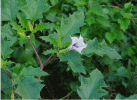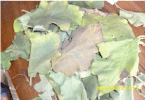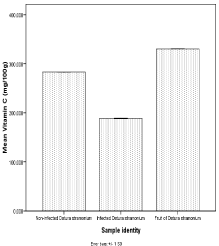
Research Article
Austin J Biotechnol Bioeng. 2017; 4(1): 1073.
Proximate and Phytochemical Analysis of the Fruits and Leaves of Datura Stramonium L, and the Effect of Fungi Associated with Foliar Blight on Them
Ibiam OFA¹*, Kalu EN², Kanayochukwu LU³ and Akpo SO4
¹Department of Biology/Microbiology/Biotechnology, Federal University, Nigeria
²Department of Applied Biology, Faculty of Biological Sciences Ebonyi State University, Abakaliki
³Department of Industrial Chemistry, Renaissance University, Nigeria
4Department of Industrial Chemistry, Ebonyi State University, Abakaliki
*Corresponding author: Onyekachi Francis Akanu Ibiam, Department of Biology/Microbiology/ Biotechnology, Federal University, Ndufu-Alike Ikwo Ebonyi State, Nigeria
Received: December 07, 2016; Accepted: March 16, 2017; Published: March 27, 2017
Abstract
Isolation and identification of fungi associated with leaf blight of Datura stramonium L was carried out. The proximate, Vitamin C, Metallic, Non-metallic Mineral composition of the apparently healthy and infected leaves, and the fruits of Datura stramonium were investigated. After the analysis, the leaves and the fruits were observed to contain anti- nutrients such as Flavonoid, Saponin, Cyanogenic glycoside, Non-metalic Minerals as Phosphate, Phosphorus, Nitrate, Nitrogen; Metallic Minerals such as Manganese, Calcium, Sodiuma, Potassium, Iron, and trace elements Cadmium, Copper, Zinc and Lead in a negligible amount; Food Nutrients; Carbohydrate, Protein, Ash, Lipid, Fiber and water, and Vitamin C. The apparently healthy leaves contained high Percentage of Flavonoid, Nitrate, Calcium, Nitrogen, Moisture, Ash and Protein when compared with the infected leaves and the fruit samples (P<0.05). The infected leaves contained high Percentage of Alkaloid, Mn, Mg and Ca (mg/100g) when compared with apparently healthy leaves sample and the fruit samples of the same species (P<0.05). The fruits of Datura stramonium sample contained high Percentage of Saponin, Cynogenic glycoside, vitamin C, Lipid, Carbohydrate and Fiber when compared with the infected samples and apparently healthy leaf sample of the plant (P<0.05). Fusarium oxysporum and Colletortichum linedenutianun were isolated from the infected leaves of the plant.
Keywords: Analysis; Foliar blight; Fungi; Mineral nutrient; Proximate
Introduction
According to Stace et al. [1], Datura stramonium is resistant to diseases and pests compared to exotic vegetables like tomatoes, and many diseases and pests. Puccinia penniseti (yellow rust), Geotrichum candidum (rusty brown leaf spot), Fusarium sp., Rhizoctonia solani, Verticillium dahliae (wilt), Gloeosporium melongenae (anthracnose), Leveillula taurica (powdery mildew), Phomopsis vexans (Phomopsis rot), Phytophthora parasitica (fruit rot).have been reported to attack the crop, but most are rarely very harmful. Certain cultivars are resistant to Cercospora solani, Thielaviopsis basicola (damping-off disease), Leucinodes orbonalis, Trialeurodes vaporariorum (whitefly), Amrasca biguttula (leaf hopper), and highly tolerant to Tetranychus urticae (spider mite) and Fusarium wilting [1]. Cultivars having fruits with a tough calyx cover and high phenolic content are more resistant to fruit borers than those without [2].
Gatumber, et al. [3], reported that the plant contains Alkaliod (3.80%), Flavonoid (2.96%), Saponin (2.30%), Cynogenicglycocide (0.002%) Phosphate (0.41%), Phosphorus (0.15%), Nitrate (88.30% Nitrogen (0.126%), Vitamin C Magnesuim (31%), Carbohydrate (8.81%), Protein (6.56%), Fibre (74%), Manganese (2%), Calcium (38%), Soduim (91%). The highly soluble minerals such as Calcim (Ca), Magnesium (Mg), Phosphorus (P), Iron (Fe) and Potassium (K), help in the maintenance of acid-base balance of the hydrogen ion concentration of the body tissues, and also help complete the absorption of vitamins, proteins, fats and carbohydrates of food [4]. Ca and Fe furnish all the cells and tissues of the body with the elements and nutritional enzymes which they need; and the higher Calcium contents of Solanum aethiopicum L, suggests that they would be more advantageous to the body in the functions associated with the minerals as Calcium is required for bone and teeth formation and in the proper functioning of the nervous system [5]. Potassium is required in muscles and nerve functions, [6]. According to [7], Phosphorus is important in the energy transfer of nucleic acids, its value ranging from 1.83mg/100g; and Iron is important in the formation hemoglobin of the blood. Harbone (2006) also reported that the leaves and fruit of the plant contain anti-nutrient such as Alkaloid which affects the central nervous system, including nerve cells of the brain and spinal cord which control many direct body functions and behaviour of man. The whole plant has an unpleasant taste, accidental poisoning f results from the consumption of a tea made from the seeds either for its alleged medicinal benefits or for its hallucinogenic effects [6].
Saponins can be widely used because of their effects on ammonia emission in animal feeding. Saponins are known to possess both microbial and anti-inflammatory activities [8]. Studies have reported the beneficial effects of spooning on blood cholesterol levels and stimulation of the immune system [9]. Appreciable amounts of metals like potassium, sodium, calcium are vital in regulation of water - electrolyte and acid-base balance in the body, provides both man and animal with rigidity and support, essentials for bone and teeth formation and development, blood clotting and normal functioning of the heart, nervous systems and the muscles respectively [5].
Justification for the work
The fruit of this plant is a delicacy in the rural areas of Ebonyi State, and no work has been done on the proximate and phytochemicals analysis and the fungi associated with the foliar blight of the plant.
Materials and Methods
The apparently healthy fruits, leaf and the infected leaf of Datura stramonium used in the study were obtained from the traditional farm land in Mgbabo achara Ezza Local Government Area in Abakaliki, Ebonyi State. Materials used were petridishes, Potato-Dextrose-Agar (PDA) media, 70% Ethanol, Sterilized scapel, binocular microscope, glass slides, cover slips, distilled water, cheese brough clothes, refrigerator, autoclave, incubator, corn borer, inoculation loop, aluminium foil, masking tape, weighing balance, measuring cylinder, conical flask, etc.
Fungal isolation
The direct method of isolation of fungal pathogens was used. The plant materials (fruits and leaves) were each cleaned to remove soils or dirt by passing them over running water, washed with several changes of distilled water, surface sterilized with 70% ethanol and cut into small pieces (4mm2) with sterilized scapel. The work bench was also cleaned with 70% ethanol. The cut pieces of the fruits and leaves were placed on a freshly prepared Potato-Dextrose-Agar (PDA) media and incubated at room temperature 25±2oC for 48 hours, after which the fungal isolates were sub-cultured into pure culture and identified based on their habit and spore characteristics using the method of Barnett, et al. [10]. The pure isolates were preserved and sub-cultured of every fresh experiment carried out with them (Figures 1-4).

Figure 1: Apparently Healthy leaves of Datura stramonium L.

Figure 2: Infected leaves of Datura stramonium L.

Figure 3: The fruit of Datura stramonium L.

Figure 4: Habit character of Fusarium oxysporum.
Analyses of the food and mineral nutrients, Vitamin C and anti-nutrients of the apparently healthy fruits and leaves, and infected leaves of Solanum aethiopicum
The freshly harvested fruits and leaves of Solanum aethiopicum termed apparently healthy and as well as the freshly harvested infected leaves analyzed in triplicate for carbohydrate, crude fibre, moisture, protein, lipid (fat); Vitamin C; mineral nutrients: anions- Nitrate,Phosphate,Phosphorus and Nitrogen; cations -Lead (Pb), Manganese (Mn), Magnesium (Mg), Zinc (Zn), Sodium (Na), Copper (Cu), Calcium (Ca), Iron(Fe) and Cadmium (Cd); and anti-nutrients- Flavonoid, Alkaloids, Saponins and Cyanogenic glycosides. Using standard method of A.O.A.C. [11].
Results
Fusarium oxysporum and Colletotrechum lindemuthianum were isolated from the leaves of Datura stramonium infected with leaf blight. (Figures 4-7): show the vegetative and reproductive structures of Fusarium oxysporum and Colletotrechum lindemuthianum. The results in Table 1 show the proximate composition of apparently healthy leaves, infected leaves and the fruit of Datura stramonium L. It was observed that there was significant reduction in the moisture, ash, protein and carbohydrate in apparently healthy leaves, infected leaves and the fruit of Datura stramonium L. (P<0.05) respectively. There was significant increase in fibre (P<0.05) in apparently healthy leaves, infected leaves and the fruit of Datura stramonium L. respectively. The result in (Figure 8) show the vitamin C content of apparently healthy leaves, infected leaves and the fruit of Datura stramonium L. It was observed that there was significant different in the contents (P<0.05). Vitamin C was highest in the fruit of Datura stramonim followed by apparently healthy leaves of Datura stramonium and least in infected leaves of Datura stramonium.

Figure 5: Spores and vegetative structure Fusarium oxysporium.

Figure 6: Habit character of Colletotrichum lindemuthianum.

Figure 7: Spores and vegetative structure of Colletotrichum lindemuthianum.

Figure 8: A histogram of mean vitamin C of the sample identity.
Food Nutrients
A.H. L
I.L
A.H. F.
Moisture
60.5±0.018
38.4±0.017
3.74±0.069
Ash
5.38±0.09
5.07±0.01
1.40±0.01
Lipid
2.19±0.023
2.01±0.041
2.47±0.036
Protein
7.877±0.03
7.646±0.05
6.580±0.02
Fibre
16.61±1.99
40.00±0.11
74.43±0.13
Carbohydrate
8.81±0.09
5.12±0.37
3.46±0.84
P < 0.05
A.H.L: Apparently Healthy Leaves; I.L: Infected Leaves; A.H. F: Apparently Healthy Fruits
Table 1: The proximate composition of apparently healthy leaves, infected leaves and the fruit of Datura stramonium in % Mean±SD.
The results in Table 2 show the metallic contents of apparently healthy leaves, infected leaves, and the fruit of Datura stramonium L. It was observed that there was significant increase in Mn, Mg, Ca, P and Na (P<0.05) in the apparently healthy leaves of the plant than infected leaves, and fruit of the plant respectively. Copper, Zinc, Cadmium and Lead were Not Detected (ND) in the three samples.
Metallic-minerals
A.H.L
IL
A. H. F
Manganese
2.03±0.03
1.93±0.025
1.85±0.030
Magnesium
73.15±3.3
44.935±1.3
12.55±1.93
Calcium
75.04±5.03
38.33±11.7
73.1±0.15
Potassium
84±1.06
72±0.22
71±0.25
Sodium
98.7±1.32
91.3±1.56
84.2±1.67
Irion
2.06±0.04
1.84±0.36
1.86±0.31
Copper
ND
ND
ND
Zinc
ND
ND
ND
Cadmium
ND
ND
ND
Lead
ND
ND
ND
P<0.05
A.H.L: Apparently Healthy Leaves; I.L: Infected Leaves; A.H. F: Apparently Healthy Fruits
Table 2: The metallic contents of apparently healthy leaves, infected leaves and the fruit of Datura stramonium L (mg/100g) Mean±SD.
The results in Table 3 show the non-metallic contents of apparently healthy leaves, infected leaves, and the fruit of the plant. It was observed that there was no significant difference in the nonmetallic mineral composition of the three samples (P>0.05) except in nitrate where the fruit of the plant has a significant reduction (P<0.05) compared to both the apparently healthy leaves and infected leaves of the plant.
Non-metallic mineral
A.H.L
I L
A.H.F
Phosphate
0.41±0.004
0.41±0.002
0.41±0.003
Phosphorus
0.16±0.004
0.15±0.004
0.16±0.005
Nitrate
88.3±0.06
88.3±0.08
44.1±0.01
Nitrogen
0.13±0.002
0.11±0.001
0.11±0.003
P>0.05
A.H.L: Apparently Healthy Leaves; I.L: Infected Leaves; A.H. F: Apparently Healthy Fruits
Table 3: The non-metallic mineral analysis of apparently healthy leaves, infected leaves and the fruit of Datura stramonium in (mg/100g) Mean±SD.
The results in Table 4 show the anti-nutrient composition of apparently healthy leaves, infected leaves, and the fruit of the plant. It was observed that there was significant difference in all the glycoside where the fruit showed a significant reduction (P<0.05) compared to both the apparently healthy leaves and infected leaves of the plant.
Anti-nutrients
A.H.L
I L
A.H.F
Alkaloid
5.13±0.03
3.81±0.01
2.59±0.03
Flavonoid
2.95±0.04
2.83±0.03
4.05±0.05
Saponin
2.29±0.01
2.03±0.03
5.50±0.01
Cytogenicglycoside
0.003±0.00
0.003±0.00
0.023±0.00
P<0.05
A.H.L: Apparently Healthy Leaves; I.L: Infected Leaves; A.H. F: Apparently Healthy Fruits
Table 4: The Anti-nutrient analysis of apparently healthy leaves, infected leaves and the fruit of Datura stramonium compared in (mg/100g) Mean±SD.
Discussion
Fusarium oxysporum and Colletotrechum lindemutianum were isolated from the leaves of Datura stramonium L. infected with leaf blight disease. The results of the proximate analysis of Datura stamonium L. in Table 1 showed that it % moisture and food nutrient content and Vitamin C in apparently healthy leaves were higher than that of infected leaves P<0.05). The fungi must have used up part of them for its metabolic activity. Ibiam, et al. [12] reported that utilization of the vitamin C, fibre, protein and the carbohydrates content of the infected leaf by the fungi during their derivative activities on the infected leaves must be responsible for their relative decrease in the infected leaves. The high fiber content of the fruit shows that the fruit has a high a cleansing ability. The % ash content is high in apparently healthy leaves sample, followed by infected leaves sample and least in the fruit sample (P<0.05. According to Cheesbrough, et al. [13] stated that fungi require vitamins for satisfactory growth.
The results of the metal analysis of Datura stamonium in Table 3 shows that it contained high Mn in infected leaves sample, followed by apparently healthy leaves sample and least in the fruit sample (P<0.05). The Mg content is very high in infected leaves sample, followed by apparently healthy leaves sample and least in the fruit sample (P<0.05). The low content of Mn, Mg, Na, k and Ca in the infected leaves could be due to the utilization of the released minerals by the organism for growth. This corroborates the claims of [14] that the micro and macro nutrients in plants are used as food by fungi and that is why they can easily attack the plants. Marsluf, et al. [15] and Heynes, et al. [16] also stated that fungi use a diverse range of organic substrates for growth including simple compounds as nitrates, ammonia, ethanol etc. There is no significant difference (P>0.05) in the phosphorus contents of the three sample identity. The nitrate content is high in the infected leaves sample, followed by apparently healthy leaves sample and least in the fruit sample (P<0.05). The % nitrogen content is high in the infected leaves sample, followed by apparently healthy leaves sample and least in the fruit sample (P<0.05). Potassium is required in muscles and nerve functions, According to Olaiya, et al. [7]. Phosphorus is important in the energy transfer of nucleic acids, its value ranging from 1.83mg/100g, and Iron is important in the formation hemoglobin of the blood.
The results of the phytochemical analysis of Datura stamonium in Table 5 shows that it contained high % Alkaloid in infected leaves sample, followed by apparently healthy leaves sample and least in the fruit (since P<0.05). The % Flavonoid content is high in the fruit sample, followed by apparently healthy leaves sample and least in infected leaves sample (P<0.05). The % Saponin content is high in the fruit sample, followed by apparently healthy leaves sample and least in infected leaves sample (P<0.05). The high levels of saponins, alkaloids and flavonoids in apparently healthy fruits and leaves relative to that of the infected leaves was high. The present investigation agrees with NHM [17] and Muller et al. [18] that alkaloids and saponins occur in relatively high levels in the plants of Solanum aethiopicum L. According to NHM, [17] high levels of alkaloids in Solanum aethiopicum L can be desirable, toxic or both and that they reduce the tendency of pathogens to invade the plants. Muller et al. [18], stated that saponins exhibit potent antifungal activities. The Cynogenic glycoside (mg/100g) content is high in the fruit sample (P<0.05) but no significant difference in the apparently healthy leaves sample and infected leaves sample (P>0.05). There is no significant difference (P>0.05) in the phosphate contents of the three sample identity. This agrees with Harbron, et al. [6] that nutrients occur in relatively high levels in the fruits and apparently healthy leaves where they have been know as major determinants of plants resistance to plant pathogen.
References
- Stace C. New Flora of the British Isles. Cambridge University Press. 1997; 532.
- Culpeper N. Culpeper's Complete Herbal, Slough: W Foulsham & Co Ltd. 2000; 368-369.
- Gatumbi H. Determination of mineral elements in some medicinal plants used for the cure of various diseases. Indian J Pharm Sci. 1990; 56: 186-187.
- Islam Rezuanul md, Paul DK, Shaha R.K. Nutritional Importance of some leafy vegetables in Bangladesh. Pak. Journal of Biological Science. 2004; 7: 1380-1384.
- Omidiji MO. Evaluation of Some F1 hybrids and Cultivars of Solamun gilo in south western Nigeria. Acta Horiculturae. 2005; 123: 91-98.
- Harbone, IO. Medicinal Plants and their cultivation. CIMAP Lucknow India. 460.
- Olaiya, C and Adebisi J. Phytoevaluation of the nutritional values of ten green leafy vegetables in South-Western Nigeria. The Internet J Nutr Wellness. 2000; 9: 132-141.
- Fawusi MOA. Nitrogen Fertilization and Storage Temperature Effects on the nutritive Value of Solanum spp Journal of Plant Foods. 1983; 5:161-167.
- Imungi JG. The Role of Indigenous Vegetation in Human Nutrition in Kenya. Nairobi: Nairobi University. 1999.
- Barrnett HL, Hunter BB. Illustrated Genera of Im. perfect Fungi Burges Publishing Company, Minnesota. 2000; 241.
- Association of official Analytical Chemists (A.O.A.C). Official methods of analysis Arlington, VA. 1999.
- Ibiam OFA, Nwigwe I. The Effect of Fungi Associated with Leaf Blight of Solanum aethiopicum L in the Field on the Nutrient and Phytochemical Composition of the Leaves and Fruits of the Plant. J Plant Pathol Microb. 2013; 10: 4172/2157-7471.
- Cheesbrogh M. Medical Laboratory Manual for Tropical Countries Vol ll Microbiology Linacre House Jordan Hill Oxford. 2000; 262-260.
- Bruning N. The Real Vitamin and Mineral Book. NY Avery Group. 1990; 3.
- Marzluf, G.A. Regulation of Nitrogen Metabolism and gene expression in fungi. Journal of Microbiological Reviews. 1981; 45: 437-461.
- Heynes MJ. Regulatory circuits of the amds gene of Aspergillums indulines. Journal of Antoine Van Leeuwenhoek. 1994; 66: 179-182.
- Natural History Museum About the family Solanaceae. London Press. 2008; 244.
- Muller S, Tobni E. Indian Medicinal Plants and Drugs- with their Medicinal Properties and Uses. Asiatic Publishing House New Delhi. 1980; 450.